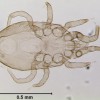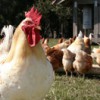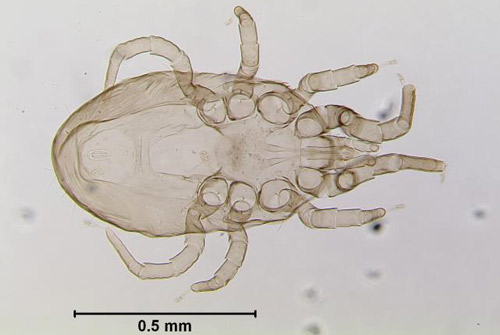 The chicken mite affects egg-laying hens in many parts of the world, including Europe, Japan, China, and the United States. Although Dermanyssus gallinae affects birds in many regions, it is most prevalent in European countries, where egg industry losses are estimated at $177 million per year. It is a known vector for the St. Louis encephalitis virus, as well as other illnesses, such as fowl pox virus, Newcastle virus, and fowl cholera. In the United States, Dermanyssus gallinae is rarely found in caged-layer operations and is more commonly found in breeder farms. This 3-page fact sheet was written by Ethan Carter and Jennifer L. Gillett-Kaufman, and published by the UF Department of Entomology and Nematology, December 2015. (Photo credit: Lyle J. Buss, University of Florida)
The chicken mite affects egg-laying hens in many parts of the world, including Europe, Japan, China, and the United States. Although Dermanyssus gallinae affects birds in many regions, it is most prevalent in European countries, where egg industry losses are estimated at $177 million per year. It is a known vector for the St. Louis encephalitis virus, as well as other illnesses, such as fowl pox virus, Newcastle virus, and fowl cholera. In the United States, Dermanyssus gallinae is rarely found in caged-layer operations and is more commonly found in breeder farms. This 3-page fact sheet was written by Ethan Carter and Jennifer L. Gillett-Kaufman, and published by the UF Department of Entomology and Nematology, December 2015. (Photo credit: Lyle J. Buss, University of Florida)
http://edis.ifas.ufl.edu/in1070
Tag: Poultry Parasites
Intestinal and Tracheal Parasites of Poultry
 A parasite is defined as an animal or plant that derives sustenance and/or protection by living in or on another animal or plant called the host. Intestinal and tracheal parasites of poultry are commonly referred to as “worms,” although this term is technically not correct. These parasites can cause chickens in a flock to appear unthrifty, which often leads to secondary complications. In some cases, the parasites can cause mortality in the flock. Frequent inspection of the flock for signs of illness is the best management tool for identifying when these parasites are a problem. This 3-page fact sheet was written by Gary D. Butcher and Michael A. Davis, and published by the UF Department of Animal Sciences, April 2014.
A parasite is defined as an animal or plant that derives sustenance and/or protection by living in or on another animal or plant called the host. Intestinal and tracheal parasites of poultry are commonly referred to as “worms,” although this term is technically not correct. These parasites can cause chickens in a flock to appear unthrifty, which often leads to secondary complications. In some cases, the parasites can cause mortality in the flock. Frequent inspection of the flock for signs of illness is the best management tool for identifying when these parasites are a problem. This 3-page fact sheet was written by Gary D. Butcher and Michael A. Davis, and published by the UF Department of Animal Sciences, April 2014.
http://edis.ifas.ufl.edu/aa078
